Land Invertebrates
Media

Species Types
Scientific Name
Loxosceles reclusa
Description
The brown recluse is a spider whose venomous bite may be medically significant to humans, though a bite is almost never fatal. Brown recluses are most commonly encountered in houses, where they occupy little-used drawers, closets, and other small hiding spaces.
Media

Species Types
Scientific Name
Nearly 250 species in North America north of Mexico
Description
A wolf spider doesn't spin webs to catch its prey — it runs it down like a wolf! Spiders in this family have long legs and are usually gray, brown, black, or tan with dark brown or black body markings (especially stripes).
Media

Species Types
Scientific Name
Pisaurina spp.
Description
Nursery web spiders build silken tents in plants to protect their egg sacs, then stand guard until the hatchlings are ready to disperse. Large and velvety, nursery web spiders have long legs and variable color patterns.
Media
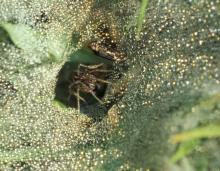
Species Types
Scientific Name
Agelenopsis spp.
Description
The funnel-shaped web of grass spiders is more often noticed than the spider itself. It is sheetlike, usually positioned horizontally, with a funnel leading downward to a shelter (a rock crevice or dense vegetation) where the spider hides, waiting for prey.
Media

Species Types
Scientific Name
About 6,500 species have been named so far, worldwide.
Description
Daddy longlegs, or harvestmen, are familiar Missouri animals. They are not spiders, but opilionids. Unlike spiders, they have a fused body form and lack silk and venom glands.
Media

Species Types
Scientific Name
Tetragnatha spp.
Description
Longjawed orbweavers are called stretch spiders because they rest with their legs stretched straight out in front of and behind their slender bodies. They build their circular webs horizontally, within a few feet above the surface of a stream or lake.
Media
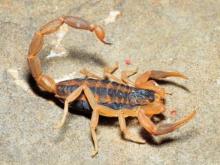
Species Types
Scientific Name
Centruroides vittatus
Description
Striped bark scorpions are pale yellowish brown, usually with two lengthwise dark stripes on the abdomen. It is the only species of scorpion in Missouri. It occurs in glades and other dry, warm, rocky areas, and sometimes in buildings and shelters and under piles of wood, brush, or garbage.
Media
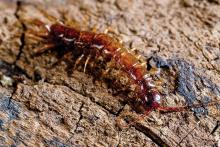
Species Types
Scientific Name
Hundreds of species in North America north of Mexico
Description
Centipedes are familiar to anyone who has overturned rocks and logs, sifted through leaf litter, or dug in the soil. Learn more about Missouri's members of class Chilopoda.
Media
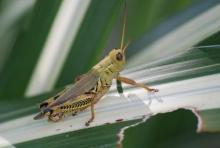
Species Types
Scientific Name
Melanoplus differentialis
Description
The differential grasshopper is familiar to most Missourians. Originally it lived only in wet meadows and creek bottomlands, but with the spread of farms, it has become a pest of many food crops.
Media
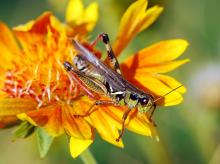
Species Types
Scientific Name
Melanoplus femurrubrum
Description
The red-legged grasshopper is a type of short-horned grasshopper common in Missouri. It reaches about 1 inch in length and is often seen flicking or flying away in open habitats.
See Also



Media

Species Types
Scientific Name
Cisseps fulvicollis
Description
The yellow-collared scape moth is more often “orange-collared.” And whether you think it looks more like a firefly or a wasp, it’s still a moth!
Media

Species Types
Scientific Name
Nearly 150 species in North America north of Mexico
Description
Slim, delicate plume moths are instantly recognizable by their T-shaped silhouette, long legs, and muted shades of tan and brown. It can be hard to separate the various species.
Media

Species Types
Scientific Name
Pyrrharctia isabella
Description
Not many people know the adult Isabella tiger moth when they see one, but we’re all acquainted with its caterpillar, the woolly worm, or woolly bear.
About Land Invertebrates in Missouri
Invertebrates are animals without backbones, including earthworms, slugs, snails, and arthropods. Arthropods—invertebrates with “jointed legs” — are a group of invertebrates that includes crayfish, shrimp, millipedes, centipedes, mites, spiders, and insects. There may be as many as 10 million species of insects alive on earth today, and they probably constitute more than 90 percent all animal species.





















